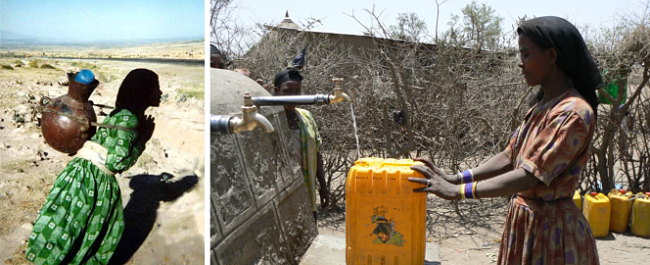Clean water linked to rising birth rates in Africa: why development initiatives must consider women’s reproductive services

This research explores the unintended consequences of foreign aid and highlights the need for community based, bottom-up approaches to rural development initiatives in Africa.
About the research
In many of the world’s poorest countries, population growth continues to hamper economic growth and the financial security of nations and individuals.
Development intervention initiatives, many funded by overseas aid, are designed specifically to respond to the needs of growing populations. However, despite the millions of dollars spent on development each year there is relatively little known about the long-term impact of these projects on the poor, particularly the potential for these to introduce unplanned population changes.
This briefing draws on a case study of rural development intervention, which involved installing clean water taps in rural Ethiopian villages. The primary goal of this project was to install village-level tap stands, thus improving access to a safe water supply and reducing the time and energy women spent carrying water.
This development intervention had dramatic effects on women’s lives. However, contrary to the expectations of development policy-makers, the results of the intervention have not all been positive.
Improving health conditions (via labour-saving technology) can introduce potentially dangerous local population growth. This research demonstrates the need for culturally appropriate family planning and reproductive services to be combined with other forms of development intervention. It also supports arguments for community-based, “bottom-up” rather than “top-down” intervention initiatives.
Policy implications
- Development interventions which impact on women’s energy levels should routinely include access to reproductive services.
- Initiatives based in low-income settings should always include an assessment of the unmet need for family planning.
- Rural development policymakers should focus on smallscale community-based, multisector schemes which deal with the full cross-section of local needs, rather than prioritising single-focus, “top down” intervention.
- NGOs should look beyond their short-term, practical objectives and invest in comprehensive monitoring and evaluation of interventions, with a view to measuring the long-term impact and effectiveness of aid. Poorly designed development projects can fail to address – or worse, exacerbate – existing problems.
- Efforts to evaluate development interventions are often overly narrow. NGOs should look to engage more closely with evolutionary scientists, to enable a fuller accounting of the costs and benefits, and to predict demographic consequences.
Key findings
In the case study, technological invention may actually have exacerbated rather than alleviated population pressures in a poor rural Ethiopian community. The installation of clean water taps in rural villages introduced notable improvements to women’s lives, reducing the time and effort they spent carrying water on their backs (from 6 hours a day to less than 30 minutes in some instances); and improving child survival (reducing the relative risk of child death by 50% for every month of life).
However, the project also introduced striking and unexpected demographic consequences. In the absence of family planning, access to water taps was linked to an immediate increase in female reproductive rates: evidence shows that improvements in women’s energy levels can lead to higher fertility. Women who gained access to taps also had shorter intervals between births than those women without access to taps. Combined with increased child survival brought about by improved water supplies, this has underpinned increases in family sizes in a population close to current environmental limits.
Based on evolutionary predictions, this case study identified unintended demographic consequences of development in rural Ethiopia. A similar approach is now being used to reveal how barriers to female education and well-being may persist (despite long-standing intervention). This can only been achieved through active collaboration with development practitioners and policy-makers working together to co-design effective interventions.
Further information
Gibson, MA & Lawson, DW, 2015, ‘Applying evolutionary anthropology’. Evolutionary anthropology, vol 24., pp. 3-14
Gibson, MA & Gurmu, E, 2012, ‘Rural to urban migration is an unforeseen impact of development intervention in Ethiopia’. PLoS One, vol 7., pp. 1-8
Gibson, MA & Mace, R, 2006, ‘An energy saving development initiative increases birth rate and childhood malnutrition in rural Ethiopia’. Public Library of Science - Medicine, vol 3 (4, e87)., pp. 476 – 484
Policy Briefing 30: 2016
Clean water linked to rising birth rates in Africa: development initiatives (PDF, 172kB)
Contact the researchers
Dr Mhairi Gibson, Reader in Anthropology,
Department of Archaeology and Anthropology,
University of Bristol:
Mhairi.gibson@bristol.ac.uk
Authors
Dr Mhairi Gibson, University of Bristol
Dr Tigist Grieve, For-Ethiopia